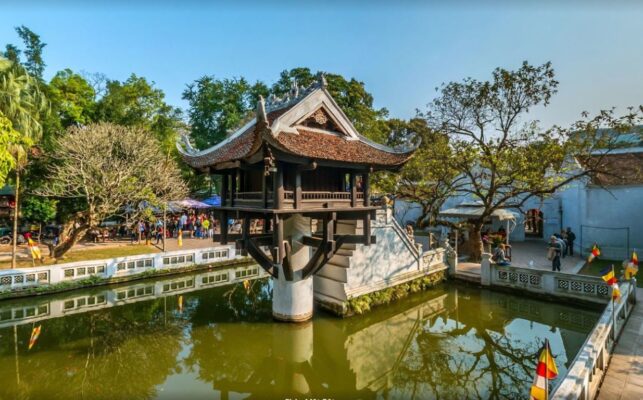ONE PILLAR PAGODA (CHUA MOT COT)
Hanoi is famous for many unique architectural works in which the One Pillar Pagoda (Chua Mot Cot) – an age-old sacred venue carrying cultural and historical imprints of the nation resides. Visitors of Silk Path coming to the capital are amazed by this impressive ancient masterpiece.

Introduction
Situated in the Ho Chi Minh Museum relics, One Pillar Pagoda attracts numerous tourists annually.
Affiliation: Buddhism
Entrance fee: Free
Opening hours: Daily | 8.00 AM – 5.00 PM
Address: Chua Mot Cot Street, Ba Dinh District, Hanoi.
From Silk Path Hotel Hanoi: 2km
From Silk Path Boutique Hanoi: 4km
Architecture

This pagoda is distinctive and unique in terms of architecture. The all-laid-on-a-pillar unique feature of One Pillar Pagoda’s architecture is a harmonious combination of spectacular ideas and architectural perfection. The structure includes 3 parts: a single round pillar, Lien Hoa Dai, and a curved pagoda roof.
The round pillar is constructed from 2 stones that connect firmly. This stone pillar is approximately 4m high (excluding the sinking part under the foot) and 1.2m in diameter. The round pillar represents the sky and Yang while the square pond represents the law and Yin, which demonstrates the direction of circulation of the universe.
Lien Hoa Dai is a square wooden structure with each side of 3m width. There is a statue of Guan Yin Buddha worshiped inside the pagoda. The statue was designed following the dream of King Ly Thai Tong – Guan Yin Buddha sitting on a lotus.
The roof is considered the most important part of the work, especially in religious buildings. One Pillar Pagoda’s roof is curved on all 4 sides with a 3m width.
It is decorated with traditional patterns of two dragons facing the moon. This pattern, to Vietnamese people, symbolizes the holy power bringing the wish for wisdom and vitality to human beings. From a distance, One Pillar Pagoda looks like a lotus flower emerging from the water’s surface. The delicate beauty of the lotus is a symbol of intelligence, elevated personality, and simple virtue of Vietnamese people.

Legend
According to legend, Emperor Ly Thai To, who had no children, used to go to pagodas to pray to Buddha for a son. One night, he dreamt that he was granted a private audience to the Bodhisattva Avalokiteshvara, who was seated on a great lotus flower in a square-shaped lotus pond on the western side of the Imperial Citadel of Thang Long and gave the King a baby boy. Months later, when the Queen gave birth to a male child, the Emperor ordered the construction of a pagoda supported by only one pillar to resemble the lotus seat of his dream in the honor of the Bodhisattva Avalokiteshvara.
According to a theory, the pagoda was built in a style of a lotus emerging out of the water.
Hanoi is famous for many unique architectural works in which the One Pillar Pagoda (Chua Mot Cot) – an age-old sacred venue carrying cultural and historical imprints of the nation resides. Visitors of Silk Path coming to the capital are amazed by this impressive ancient masterpiece.

Introduction
Situated in the Ho Chi Minh Museum relics, One Pillar Pagoda attracts numerous tourists annually.
Affiliation: Buddhism
Entrance fee: Free
Opening hours: Daily | 8.00 AM – 5.00 PM
Address: Chua Mot Cot Street, Ba Dinh District, Hanoi.
From Silk Path Hotel Hanoi: 2km
From Silk Path Boutique Hanoi: 4km
Architecture

The round pillar is constructed from 2 stones that connect firmly. This stone pillar is approximately 4m high (excluding the sinking part under the foot) and 1.2m in diameter. The round pillar represents the sky and Yang while the square pond represents the law and Yin, which demonstrates the direction of circulation of the universe.
Lien Hoa Dai is a square wooden structure with each side of 3m width. There is a statue of Guan Yin Buddha worshiped inside the pagoda. The statue was designed following the dream of King Ly Thai Tong – Guan Yin Buddha sitting on a lotus.
The roof is considered the most important part of the work, especially in religious buildings. One Pillar Pagoda’s roof is curved on all 4 sides with a 3m width.
It is decorated with traditional patterns of two dragons facing the moon. This pattern, to Vietnamese people, symbolizes the holy power bringing the wish for wisdom and vitality to human beings. From a distance, One Pillar Pagoda looks like a lotus flower emerging from the water’s surface. The delicate beauty of the lotus is a symbol of intelligence, elevated personality, and simple virtue of Vietnamese people.

Legend
According to legend, Emperor Ly Thai To, who had no children, used to go to pagodas to pray to Buddha for a son. One night, he dreamt that he was granted a private audience to the Bodhisattva Avalokiteshvara, who was seated on a great lotus flower in a square-shaped lotus pond on the western side of the Imperial Citadel of Thang Long and gave the King a baby boy. Months later, when the Queen gave birth to a male child, the Emperor ordered the construction of a pagoda supported by only one pillar to resemble the lotus seat of his dream in the honor of the Bodhisattva Avalokiteshvara.
According to a theory, the pagoda was built in a style of a lotus emerging out of the water.
